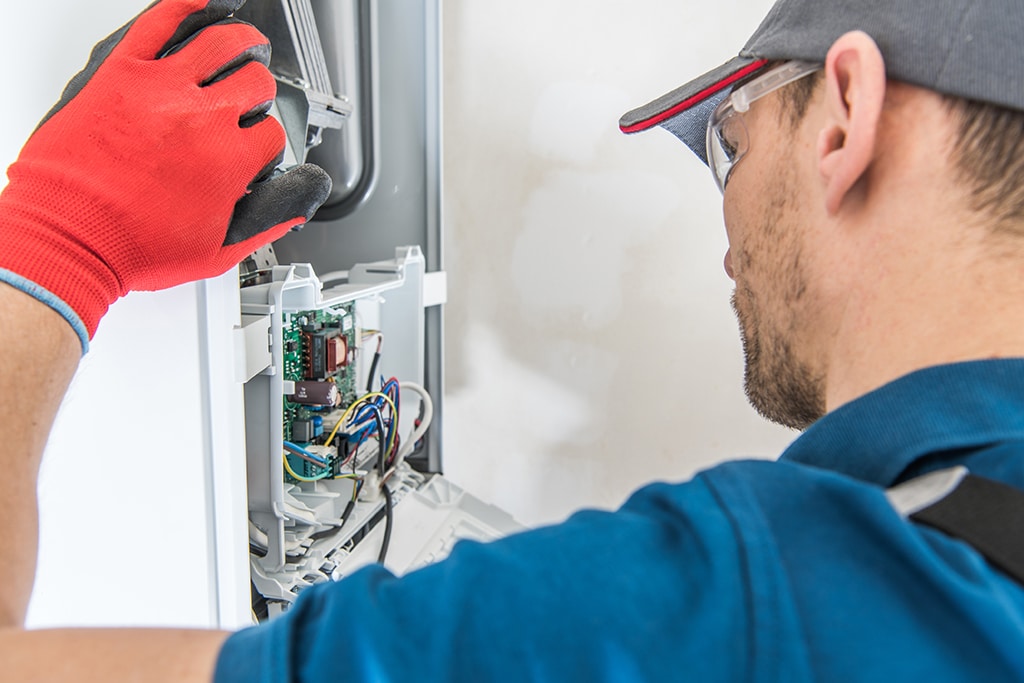
A Malfunctioning Furnace Flame Sensor Needs Emergency Heating And AC Repair | Lewisville, TX
The furnace you are supposed to count on to ensure that your home is warm during the coldest month of the year might start to cycle rapidly and even turn off. Or maybe it tries to kick on and runs only for a few seconds before it kicks out the pilot light. This could be a panic-inducing situation that warrants a call to an emergency heating and AC repair technician. It could be that the furnace flame sensor has a problem like it is dirty and requires cleaning. So, what is a dirty flame sensor, and how can a professional help?
What’s a Flame Sensor in a Furnace?
A flame sensor is a component of your furnace. It is a very thin metallic rod located in the burner assembly. The furnace flame sensor is usually bent and sits in front of the pilot flame within the furnace. Whenever the thermostat sends the signal to the furnace to start, the gas valve in the unit opens up, firing gas into the furnace combustion chamber. In the chamber, the pilot light or the ignitors lights the burners.
The flame sensor is there to confirm that fire is present when the gas valve is open. Without the sensor, the pilot light could go out abruptly, filling your indoor space with dangerous gas. This is the main reason why a malfunctioning flame sensor requires the attention of an emergency heating and AC repair technician. The toxic gas can accumulate in your home and become deadly for many reasons, from potential fire explosions and gas poisoning.
Therefore, the flame sensor is among the many furnace safety measures. If the sensor doesn’t detect a flame from the furnace when the gas valve is open, it automatically shuts your furnace down to ensure that your home is safe. In many modern HVAC units, the shutdown can arise up to 3 times before the air conditioning system goes into lockout. If it enters the lockout, it will sit for an hour before it again tries to kick on. This ensures that any gas produced dissipates.
Unfortunately, should there be a flame and the furnace flame sensor doesn’t detect it, it can become stuck without heat for about an hour. At worst, it could create a lot of wear and tear on the other furnace components. Hence, if you sense or suspect that the furnace flame sensor is faulty, you should immediately notify a heating and AC repair technician for an inspection. Otherwise, you risk gas poisoning, expensive fixes, and an inefficient system.
Thermocouple vs Furnace Flame Sensor
Some people interchangeably use the terms thermocouple and furnace flame sensor. Although they perform the same task, they aren’t the same. If your furnace has an electronic controller, it has a flame sensor. In contrast, a thermocouple is usually used on a stationary pilot furnace system with pilot lights. It sits close to the pilot light & determines whether it is properly functioning. On the other hand, the flame sensor detects if the burners are lit once the gas valves are open. However, they both need the attention of an emergency heating and AC repair technician if they become faulty or begin malfunctioning.
A Dirty Flame Sensor Is a Culprit in Most Instances
In most instances, the issue is not a bad component of faulty equipment. It is simply a dirty or corroded flame sensor. Because the flame sensor spends a lot of time immersed within the flame, it can collect carbon deposits and other particles like dust that might burn onto the furnace flame sensor. As mentioned above, the furnace flame sensor is a sensitive wire that should detect any fire quickly. Hence, even the slightest deposits or collections can fail, prompting you to call an emergency heating and AC repair technician.
Signs of a Dirty Flame Sensor
Several immediately discernible signs indicate that your furnace flame sensor is clogged, rusted, or otherwise defective:
- See whether your gas burners glow briefly before going off. This is the commonest indication of a sensor problem.
- Cleaning is necessary if you can see soot covering the sensor’s tip. When the tip is black, you know it’s time for service.
- You’ll need to call an emergency heating and AC repair technician in Lewisville, TX for a replacement if the sensor casing has porcelain cracks.
The porcelain is a crucial insulator to prevent the sensor from becoming grounded on the furnace bracket.
How Can the Professionals Help?
When the emergency heating and AC repair technician attends to your problem, they will turn off the furnace and begin cleaning the furnace flame sensor. The process of cleaning the furnace flame sensor is multi-step, and the professional will:
Turn the Furnace Off
The emergency heating and air conditioning repair technician will turn off the furnace first. Since a furnace has hot electrical components, working on it while on can have devastating impacts like electrocution, fire hazard, gas poisoning, or severe burns.
Removing the Old Sensor
Next, the emergency heating and AC repair technician in Lewisville, TX will detach the old sensor from the furnace for cleaning. They might have to detach a wire at the end of the sensor to have more room to work.
Cleaning the Sensor
Then, the technician will use steel wool, light-grained sandpaper, or even a wire brush to rub the metal rod gently to clean the dirty flame sensor. After removing all the grit, they will use a paper towel or a soft cloth to wipe the sensor.
Reconnecting the Sensor
After cleaning it, the professional will reconnect the sensor and the wire. Then, the technician will test to ensure that the flame sensor is working fine.
Are You facing a furnace flame sensor problem in your Lewisville, TX home? You can avoid it through routine HVAC maintenance. Contact us at One Hour Air Conditioning & Heating of Dallas, your reliable emergency heating and AC repair technicians.






